


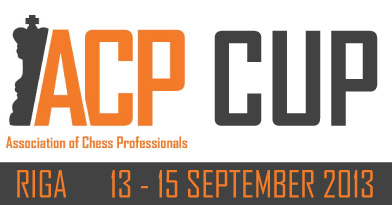
The ACP cup runs from the 13th of September to the 15th of September in Riga, Latvia. The tournament will be a rapid event with blitz tiebreaks in a knock out format. The pairings will be somewhat unusual, as the four highest rated players will be randomly paired against the four lowest rated players, consequently the players ranked fifth to eighth will be randomly paired against the players ranked ninth to twelfth. The tournament will follow FIDE rapid play rules and FIDE blitz play rules for the normal portion and the tiebreaks.
The matches will consist of 25 minutes per player at the start of the game with 10 seconds increment from move one. In case of a tiebreak the games will move to 3 minutes with 2 seconds increment. Finally, an Armageddon will be used where White starts with 5 minutes and must win against Black's 4 minutes; at the 61st move however players will begin to receive a 2 second increment.

Semi-Finals
The Semi-Finals started with a bang: Grischuk was able to dispatch Svidler in a game that could honestly have gone either way. A victory with black proved to be very important and a subsequent draw allowed Sasha Grischuk to reach the finals.

[Event "ACP Cup 2013"] [Site "Riga LAT"] [Date "2013.09.15"] [Round "3.1"] [White "Svidler, Peter"] [Black "Grischuk, Alexander"] [Result "0-1"] [ECO "B30"] [WhiteElo "2746"] [BlackElo "2785"] [Annotator "Ramirez Alvarez,Alejandro"] [PlyCount "106"] [EventDate "2013.09.13"] 1. e4 c5 2. Nf3 Nc6 3. Bb5 e6 4. O-O Nge7 5. Re1 Nd4 {This sortie is normal in these kinds of positions: The knight on e7 can now move without allowing the bishop on b5 to take on c6 and double Black's pawns, while the pawn on d4 will be a burden for White's development.} 6. Nxd4 cxd4 7. d3 a6 8. Ba4 b5 9. Bb3 Nc6 10. Nd2 Bb7 11. h3 Rc8 12. a4 Bb4 13. Qg4 Qf6 14. axb5 axb5 15. Qh5 {Black simply cannot complain about the position he obtained from the opening.} Qe5 16. Qh4 Qf6 17. Qh5 Qe5 18. Qh4 Qc5 $1 {Fighting spirit. Despite being black in the first game, Grischuk senses that his position is good enough to attempt a win and he isn't shy about going for it.} (18... Qf6 $11) 19. Qg3 O-O 20. e5 $6 {The pawn becomes too weak.} (20. Rf1 {trying to mobilize the knight on d2.. .} Kh8 21. Nf3 f6 {and maybe White is worse but it is not serious.}) 20... Kh8 $2 (20... Ra8 {was safer and better.}) 21. Ne4 $1 {If the pawn is weak, just give it away.} Qxe5 22. Bf4 Qh5 23. c3 Be7 24. Nd6 Bxd6 25. Bxd6 {White's compensation is sufficent, but despite his strong darsksquare control he cannot do anything as Black's structure is extremely solid.} Rfe8 26. c4 bxc4 27. Bxc4 Ne7 28. Qg4 {Even though Black has more material he faces some problems in any endgame as d4 is hard to defend, the b-pawn is passed and White's bishops are rather poewrful.} Qg6 {Grischuk at elast tries to improve his structure if the queens will be traded off.} 29. Ra7 Bc6 30. b4 Nf5 31. Bh2 Ra8 32. Qxg6 hxg6 33. Rea1 d5 34. Rxa8 Bxa8 35. Bb5 Rc8 36. Bd7 Rd8 37. Ra7 f6 38. g4 $6 (38. Bxe6 $16 {was simple and good. After this White's advantage is clear.}) 38... Nh4 39. Bd6 $6 Bc6 $1 {An important resource. The knight will get back in time to defend against the pawn advancing and Black gets rid of his bad bishop.} 40. Bxc6 Rxd6 41. b5 Nf3+ 42. Kg2 $2 (42. Kf1 Ne5 43. f4 Nxd3 44. Rc7 $1 {Would still give Black problems in figuring out how to defend against b7.}) 42... Ne1+ 43. Kf1 Nxd3 44. Rd7 Rxd7 45. Bxd7 Nc5 46. Bc8 Kg8 47. b6 Kf7 48. b7 Na6 $1 (48... Nxb7 49. Bxb7 {is senseless, the pawn on b7 will not survive long.}) 49. f4 g5 50. f5 e5 51. Be6+ Ke7 52. Bxd5 Kd6 53. Bc4 Nb8 { Black will attack c7, maneouver his knight to c5 and take White's last hope. A fabulous game!} 0-1
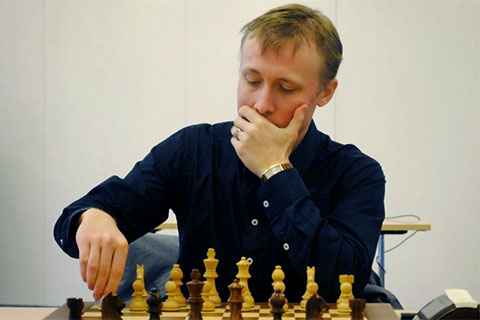
Ponomariov came close, but wasn't able to hold the second game of the match
In the other match there was a much closer struggle. Ruslan Ponomariov quickly took the lead by winning a nice Gruenfeld against Ian Nepomniatchi. However the Russian youngster struck back with a very aggressive version of the Orthodox Queen's Gambit Declined. In the tiebreaks Ponomariov committed a mistake in game one and lost while completely collapsing in game two, which allowed Nepo to go to the finals with a score of 3-1.

[Event "ACP Cup 2013"] [Site "Riga LAT"] [Date "2013.09.15"] [Round "3.2"] [White "Nepomniachtchi, Ian"] [Black "Ponomariov, Ruslan"] [Result "1-0"] [ECO "D31"] [WhiteElo "2717"] [BlackElo "2756"] [PlyCount "65"] [EventDate "2013.09.13"] {With Ponomariov having won the first game with White, "Nepo" was in a dire situation.} 1. c4 e6 2. Nc3 d5 3. d4 Be7 4. cxd5 exd5 5. Bf4 c6 6. e3 Bf5 7. g4 Be6 8. h4 Nd7 9. g5 h6 10. g6 $1 {No holding back! In only 10 moves of chess this little pawn has made it to the 6th rank and will capture on f7. White loses time but breaks apart his opponent's king's cover.} Ngf6 11. gxf7+ Bxf7 12. Bd3 Ne4 {Interestingly this position had already been played by Ponomariov. .. but with White! It was his game against Riazantsev earlier this year.} 13. Bxe4 (13. Nxe4 dxe4 14. Bxe4 Nf6 15. Bf3 O-O 16. Ne2 c5 17. Rg1 $16 { Ponomariov-Riazantsev, 2013}) 13... dxe4 14. Nge2 {Black has some problems with his e4 pawn and king positioning, but never underestimate the power of the two bishops.} O-O 15. Qc2 Nf6 16. Rg1 Kh8 17. Be5 {White's pressure is intensifying, and in a rapid game you never want to be on the defensive.} Qa5 18. Nf4 Bb4 19. Bxf6 (19. f3 $5 {sets up a nasty trap:} exf3 20. Ng6+ Bxg6 21. Qxg6 Bxc3+ 22. Kd1 $1 {and suddenly black is defenseless!}) 19... gxf6 20. Qxe4 Rg8 21. Rxg8+ (21. Kd2 $5 {keeping the tension, was worth playing.}) 21... Rxg8 22. Kd2 {Black's obtained serious counterplay, but a pawn is a pawn.} f5 23. Qf3 Bc4 $2 {This move looks much better than it is. Now Nepo gets a free attack.} (23... Bd6 {was far more subtle and kept chances alive for both players.}) 24. Qh5 Kh7 25. d5 $1 {Very annoying! Either the bishop or the queen are cut off from the defense!} Bxd5 26. Qxf5+ Kh8 27. Ng6+ Kg7 28. Ne7 Bxc3+ 29. bxc3 Rd8 30. Qe5+ Kf7 31. Nf5 {Extremely precise and fearless play. There are no important discoveries as the countercheck Nd6+ covers them all.} Rd7 32. Nd6+ Kf8 33. Qe8+ {Nepo shows cold blood in this tournament.} 1-0
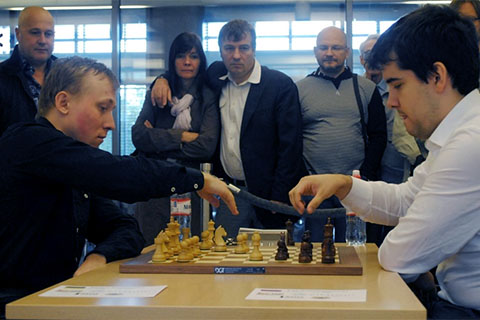
Finals: Grischuk-Nepomniatchi
Nepomniatchi definitely let go of a golden opportunity as he was completely winning in game one of the final match, and with the black pieces! Some unexpected counterplay allowed Grischuk to pull of a miracle escape and survive the first game. The second game also gave Nepo some chances but he again let them slip and a draw was agreed.
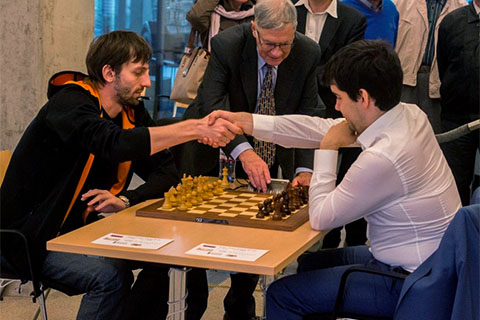
In the first tiebreak Grischuk obtained a quick pair of bishops and then an exchange, more than enough to be a decisive advantage and he took game one. Nepomniatchi retaliated in a Petroff where he always held a nagging initiative that at the end proved to be too much for the Black pieces. The game was decided in the following Armageddon:

[Event "ACP Cup 2013"] [Site "Riga LAT"] [Date "2013.09.15"] [Round "4.5"] [White "Grischuk, Alexander"] [Black "Nepomniachtchi, Ian"] [Result "1-0"] [ECO "E60"] [WhiteElo "2785"] [BlackElo "2717"] [Annotator "Ramirez Alvarez, Alejandro"] [PlyCount "87"] [EventDate "2013.09.13"] 1. d4 Nf6 2. c4 g6 3. Nf3 Bg7 4. e3 O-O 5. Be2 d5 6. cxd5 Nxd5 7. e4 Nb6 8. O-O {Grischuk had used this idea in the first round of the tiebreak match. White loses a tempo but obtains his strong center without exchanging knights which means that any counterplay with c5 is less dangerous.} Bg4 9. Nbd2 Nc6 10. d5 Nb8 11. a4 c6 12. a5 N6d7 13. h3 Bxf3 14. Nxf3 {White has already obtained a strong advantage. The pair of bishops coupled with more space and some restrictions and Black's knights means that the second player will suffer for some time.} Nf6 15. Qb3 Qc8 16. Bg5 Nxe4 17. Bxe7 Re8 18. d6 Nxd6 19. Bxd6 Rxe2 {White has lost a pawn, but he obtains some dangerous initiative.} 20. Ng5 Qd7 $2 {The decisive mistake.} (20... Qe8 {was the only move} 21. Qxb7 Nd7 {and Black is still holding, even though he is worse.}) 21. Rae1 $1 Rxb2 22. Qc4 $1 {A quiet move, but now the threat of Re7 is unstoppable and the attack crashes through.} Na6 23. Re7 Qf5 24. Rxf7 Qd5 25. Rxg7+ $1 Kxg7 26. Qc3+ $2 {Winning but in a more difficult way.} (26. Be5+ $1 {A move Grischuk would certainly not have missed in classical chess... but speed and mistakes are part of the fun in rapid!} Kg8 (26... Qxe5 27. Qf7+ Kh6 28. Qxh7+ Kxg5 29. f4+ Qxf4 30. Qe7+ {wins the queen for free and black will be mated soon.}) 27. Qh4 $1 h5 28. Bxb2 {a full piece and a winning attack.}) 26... Kg8 27. Qxb2 Qxd6 28. Qxb7 Nc7 29. Ne4 {White still has a strong edge and an extra pawn, but he has to win all over again.} Qe5 30. Qxc6 Rf8 31. Qc4+ Kg7 32. Rd1 Rf7 33. Nc5 h5 34. f3 Qe3+ 35. Kh1 Qf2 $2 {Making White's task easier.} (35... Ne8 $1 {Coming back to cover some squares.} 36. Ne6+ Kh6 {is still playable.}) 36. Qc3+ Kh7 37. Rd8 Rg7 38. Ne4 Qf1+ 39. Kh2 Qb5 40. Nf6+ Kh6 41. Rh8+ Kg5 42. Ne4+ Kf4 43. Qxg7 ( 43. g3+ Kf5 44. Qf6# {was faster, but who is counting?}) 43... Nd5 44. Qd4 1-0
The ACP Cup was full of exciting and fun chess. The time control was simply the perfect battle ground for these players who suffered many blunders, huge evaluation swings and enjoyed a fun event. The live commentary was surprisingly able to keep up with the players even in the Armageddon final, which is amazing considering that it was just a blitz game!
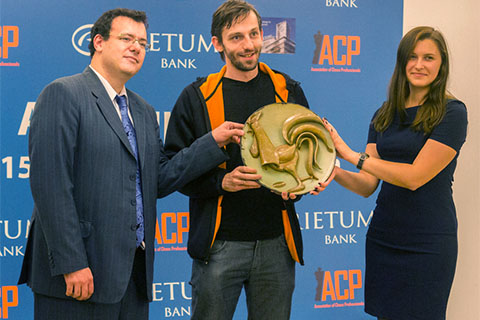
The winner and his trophy, to the left Emil Sutovsky, president of the ACP. The trophy depicts one of the symbols of the host city: the Riga Roosters.

all photos by Lennart Ootes

LinksThe games will be broadcast live on the official web site and on the chess server Playchess.com. If you are not a member you can download a free Playchess client there and get immediate access. You can also use ChessBase 12 or any of our Fritz compatible chess programs. |